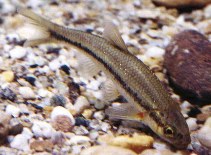| Family: |
Leuciscidae (Minnows), subfamily: Leuciscinae |
| Max. size: |
25 cm TL (male/unsexed) |
| Environment: |
benthopelagic; freshwater |
| Distribution: |
Europe: Mediterranean basin from Aude to Var drainages (France, Switzerland); literature records from Tarn system [Garonne drainage] in fact refers to Hérault [each has a tributary named Dourbie]; Soca drainage in Italy and Slovenia; uppermost Rhine drainage in Germany and Switzerland; Danube drainage in western tributaries of Germany, Austria, Slovenia, Croatia and part of Bosnia-Herzegovina, and upper Tisza system (Romania, Ukraine). Record from Aegean basin in Bulgaria based on misidentification of a possibly unnamed species. Introgression zone with Telestes muticellus in Var drainage (France) and Soca drainage (Slovenia, Italy). Telestes souffia agassii is often applied to Danube and Rhine populations, but there is no published evidence that they differ from the Rhône populations. If justified, the correct name for a Danube-Rhine species would be Telestes rysela and not Telestes agassii. |
| Diagnosis: |
Dorsal spines (total): 2-3; Dorsal soft rays (total): 7-9; Anal spines: 3-3; Anal soft rays: 9-10; Vertebrae: 41-42. Diagnosed from its congeners by having the following characters: conspicuous black midlateral stripe and conspicuous black line along lateral line in preserved individuals; in life, broad gold-orange stripe; lateral line yellow, bordered on each side by a narrow black line; 44-57 + 2-3 scales along lateral line (usually 50-57 + 2-3); 4½-5 scale rows between lateral line and pelvic fin origin; anal fin usually with 9½ branched rays; snout tip rounded or blunt, snout projecting beyond tip of upper lip; and eye diameter 4.0-4.6 times in HL (Ref. 59043). Caudal fin with 17 to 21 rays (Ref. 40476). |
| Biology: |
Adults inhabit middle reaches of streams and rivers with clear water, moderately swift current and gravel bottom. Occurs in groups. They feed on invertebrates and algae. Breeding occurs in fast-flowing water on gravel bottom (Ref. 59043). Used as bait. Not so well fished although the flesh is excellent (Ref. 30578). Locally threatened (Ref. 59043). |
| IUCN Red List Status: |
Least Concern (LC); Date assessed: 01 January 2008 Ref. (130435)
|
| Threat to humans: |
harmless |
Source and more info: www.fishbase.org. For personal, classroom, and other internal use only. Not for publication.
